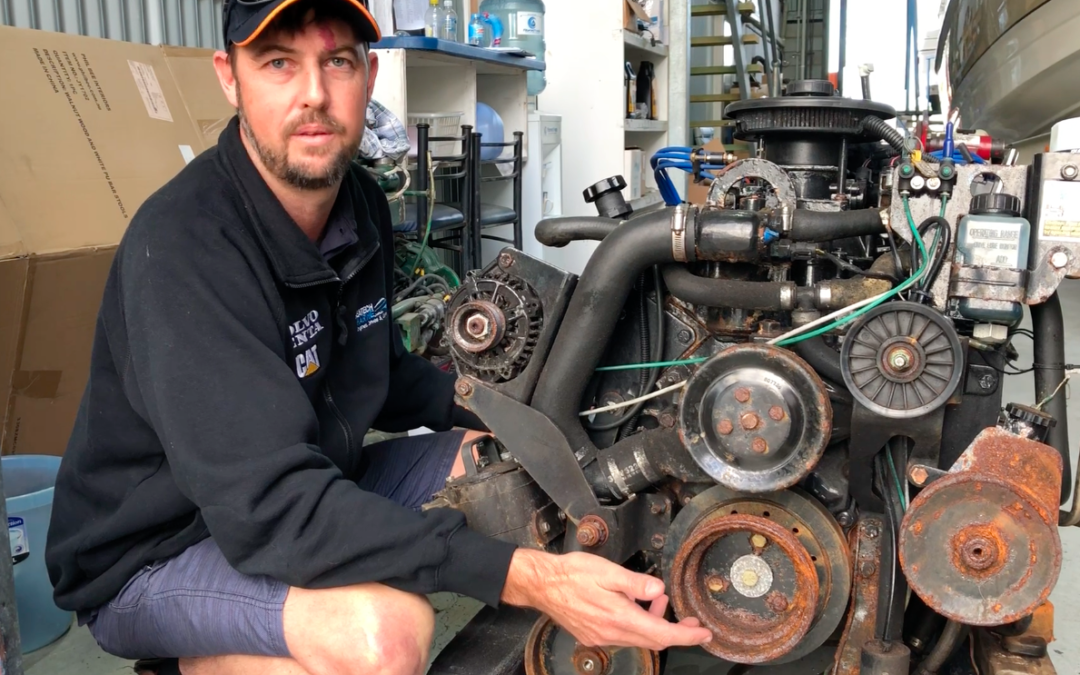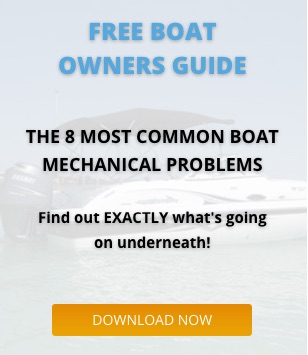In this video blog, Jon, our service manager, talks about the simple ways you can maintain the value of your boat.
Jon:
Hi Mel. Regular servicing, it keeps up on the keep-up for the engine itself; things like periodical maintenance of water pumps, fuel filters [and] just keep up the appearance of the motor. For a visual inspection for prospective client that actually looks at the motor. It is more appealing if someone lifts the engine lid, looks in and it is all presentable. If we look at this one particular, this one has come in for a pre-purchase inspection and you see that the look of the engine, it doesn’t look good.
Melanie:
So, show us what you are talking about here Jon.
Jon:
So, this has come in for a pre-purchase inspection. We actually have a tick sheet that we go through. We go through the items that we notice are problems. … When we lifted it up, obviously little things, the belt pullie was hanging on the bilge. The actual dry belt that pumps the water through the motor. This is the water pump on a Bravo motor that was hung in the bilge so engine cannot pump water without this dry belt. … This is sea salt, this has broken off, the belt on the side. We got the manifolds over on the rack there. This, in the end of the day, has come in for a pre-purchase inspection and it is probably going to have an invoice up around the $10,000 mark.
Melanie:
Okay and so if they don’t get all this work done before they sell it, how much do you think they have lost on the value of their boat?
Jon:
So your purchaser is buying the hull. The hull itself. It is the same as the engine on its own, without it, the boat is worth nothing and vice versa. 23-foot boat without an engine to go boating is worth hull value, which is $10,000 compared to $40,000.
Melanie:
Yeah, okay. So in this case, if they had have carried out their regular maintenance…
Jon:
Regular maintenance would have kept up on this. The owner would have realised the squealing belts, hanging pullies, what not. … You do periodical maintenance for that reason. Leaking manifolds … have leaked salt water down at starter motors, fuel pumps and all these are quite key components. When you let salt water run over it, they are components that don’t deal with salt water over them.
Melanie:
Okay so it has cost this owner about $20,000, I think you said.
Jon:
This will come in about ten with manifolds. We will try to sandblast, respray, just try to save the client some money. …These are just so badly corroded, we got to put new items on. There is no cutting corners with this. Limited access too in this particular boat so while it’s out, we can do things that you normally can’t do while the motor is in the boat. We roll it over and do some … seals so we know when it goes in it is oil tight, water tight, no leaks. It will be all sprayed up so when he goes to sell it, they lift the engine up [and] go “oh wow”.
Melanie:
So I think you were telling me that they could have normally sold this boat for about $40,000, that is at resale value, but at the moment it would only get about $10,000 because he needs all this work done.
Jon:
Exactly. So it’s catch fifty. Do you spend $10,000 and make $20,000 more or do you cut your losses and sell for $10,000 which has cost you $30,000.
Melanie:
Whereas if he had regular maintenance, he wouldn’t be facing that. He’d be getting $40,000 for his boat.
Jon:
Yes, definitely. As rule of thumb, a good indication, not a firm guarantee [though], but if you allow yourself about 10-15% of the total value of the actual boat per year for the up-keep, servicing, antifouling, detailing. It is a good guideline to go by.
Melanie:
Okay. And this way you can avoid losing money on the resale value of your boat when you decide to sell.
Jon:
Definitely
Melanie:
Okay. Thanks a lot for your tips Jon.



